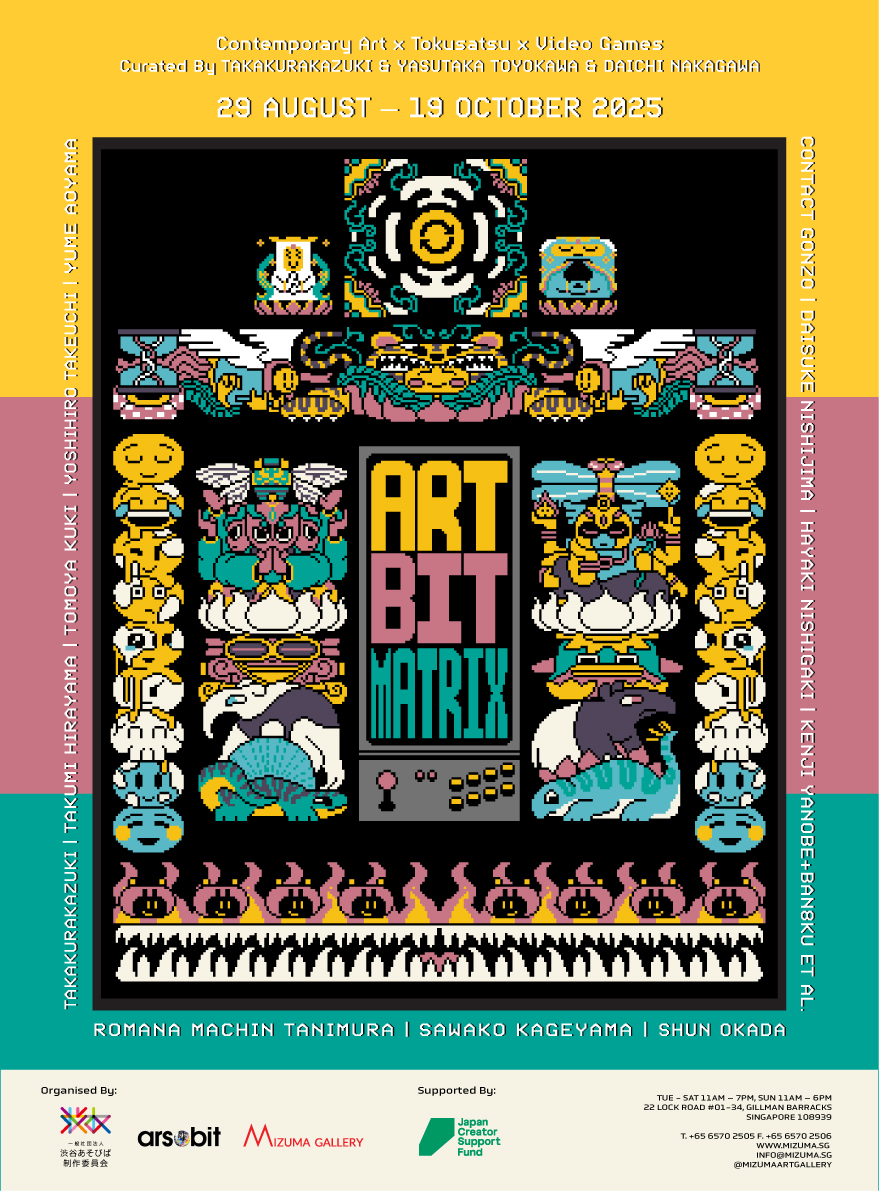
Held annually in summer at Hotel Anterum Kyoto, the contemporary art and indie game exhibition“art bit – Contemporary Art & Indie Game Culture” (hereinafter referred to as the art bit exhibition) and the group exhibition “Character Matrix” curated by contemporary artist Takakurakazuki will collaborate to present a new exhibition, “ART BIT MATRIX -TOKSATSU to VIDEOGAME-,” which will take place in Singapore starting August 29, 2025.
The art bit exhibition focuses on the mirror-like interplay between the game-like qualities of contemporary art and the artistic potential of indie games, exploring the roots of their mutual appeal and creativity to pursue new possibilities for art and games. The Character Matrix exhibition delves into the world of character variations as vessels for expression, exploring the realm of tokusatsu (special effects) and games that have been overlooked by the domestic contemporary art scene.
The 12 artists selected for both exhibitions will come together to fuse the Western-origin modern art history, which functions as a game of value inversion surrounding the principles and contexts of “beauty,” with the accumulated traditions of sacred, secular, and playful elements that have flowed into Japan from Asia.From playful paintings, sculptures, and videos to playable analog and digital game works, a pluralistic art mandala (matrix) where all mediums coexist will emerge.
■The Virtual and Real Worlds of Tokusatsu and Video Games
The focus of this exhibition, held at Mizuma Gallery’s Southeast Asian branch, which has been at the forefront of Japanese contemporary art history since the 1990s, is the “characters as magical vessels” that have been passed down from special effects to games.
Tokusatsu reimagine reality as a fantasy world, while games install the virtual world into reality.Referencing the lineage of artists influenced by Surrealism and Dadaism, such as Narita Tōru and Takayama Ryōsaku, who sculpted special effects monsters from the “Ultraman” series, and the subsequent creation of game characters like “Pokémon,” this exhibition introduces an emerging art movement that emerges from the intersection of special effects and games, which traverse between reality and virtuality.
This is also an attempt to reexamine the aesthetic and social roots of “Super Flat,” which Takashi Murakami identified in the early 21st century as a counter to Western art history in the representation of postwar Japanese manga and anime characters, transcending the boundaries of 2D and 3D, and to rediscover the possibilities that were lost in the subsequent otaku culture/internet culture, expanding it into a larger context of world art history.
As a starting point, we have invited Kenji Yanobe, a world-renowned artist who has incorporated the genetic code of post-war Japanese tokusatsu films related to nuclear power into his sculptures, alongside the rise of Superflat.
His “SHIP’S CAT” series, featuring a “sailor cat” motif that watches over people’s journeys, is installed at the Osaka Nakanoshima Museum of Art and has become one of Yanobe’s iconic works in recent years.Furthermore, Yanobe’s creative myth “BIG CAT BANG,” which reinterprets Taro Okamoto’s “Sun Tower,” left to humanity at the 1970 Osaka Expo, as a ‘spaceship’ carrying the ancestors of Earth’s life, features a “space cat” as its protagonist. The visuals are created by pixel artist BAN8KU, and the new arcade cabinet work, which incorporates a video game produced by the game design team of Kyoto University of the Arts and Osaka Electro-Communication University and Soai University. This new arcade cabinet work will be unveiled for the first time. It is a sculptural work that exists as a physical object in the real world while also containing a virtual space where one can interact with a virtual game world through characters, introducing the worldview of this exhibition (*The opening movie of the currently in-production game will be screened alongside the cabinet during this exhibition).
■The plurality of ‘play’ and ‘pray’ coexisting in diverse media
Yoshihiro Takeuchi and Shun Okada reinterpret the interactive mechanics and glitches inherent in video games as new principles of painting, confronting Western art history with abstract chaos from which original characters emerge.Hayaki Nishigaki’s paintings transform the traces of “Godzilla,” the origin of tokusatsu kaiju, into a critical spectacle of modern urban landscapes by borrowing traditional Japanese painting techniques, extracting the artistic potential shared between tokusatsu and games.
In contrast, Yume Aoyama and Meichin Romana Tanimura shape mythical beasts and monsters at the intersection of two-dimensional and three-dimensional space, while Hirayama Takumi and Kuki Tomoya summon clay and ceramic figurines as spirits of the real environment.and Sawako Kageyama, who animates a fictional TV show featuring pop half-human characters, are artists of the “Pokémon” generation who find various monsters in toys and stationery that color everyday spaces, imbuing diverse media with divine spirits and manifesting a polytheistic mandala-like character matrix.
Additionally, contact Gonzo installs a 6-meter-long coin game as a bodiless performance, and Daisuke Nishijima deconstructs the classic Super Famicom console into a “non-shooting shooter” inspired by “Space Invaders.”and Takakurakazuki’s game works housed in Buddhist altar sculptures as vessels for meditation rituals, all function as magical devices that traverse the virtual and real worlds, transforming the closed play of the game center’s magic circle into an open prayer for the world.
From tokusatsu, a genre deeply marked by the threat of nuclear war, to video games, which have become a common language of modern entertainment. As Japan marks 80 years since the end of World War II, what messages can be found in the history of Japanese culture, and what artistic possibilities can be explored in a world where the ravages of war are once again spreading?
■Event Overview
Title: ART BIT MATRIX -TOKSATSU to VIDEOGAME-
Dates: August 29 (Fri) to October 19 (Sun), 2025
Tues-Sat 11:00-19:00 / Sun 11:00-18:00 (Closed on Mondays)
☆Opening Reception: August 29 (Fri), 2025, 16:00-19:00
Venue: MIZUMA GALLERY (SINGAPORE)
22 Lock Road #01-34, Gillman Barracks, Singapore 108939
Admission: Free
Organized by Shibuya Asobiba Production Committee / MIZUMA ART GALLERY![]()
Supported by
Exhibiting Artists
Kenji Yanobe + BAN8KU + YANOKEN PROJECT
Curation
Daichi Nakagawa
Takakurakazuki
Yasutaka Toyokawa
